-
 Bitcoin
Bitcoin $108,165.4587
0.78% -
 Ethereum
Ethereum $2,456.3517
1.15% -
 Tether USDt
Tether USDt $1.0003
0.00% -
 XRP
XRP $2.1934
0.05% -
 BNB
BNB $650.0935
0.52% -
 Solana
Solana $151.3905
2.69% -
 USDC
USDC $0.9998
0.00% -
 TRON
TRON $0.2751
-0.32% -
 Dogecoin
Dogecoin $0.1640
0.87% -
 Cardano
Cardano $0.5631
0.57% -
 Hyperliquid
Hyperliquid $38.7115
4.69% -
 Bitcoin Cash
Bitcoin Cash $493.1868
-0.39% -
 Sui
Sui $2.8217
3.61% -
 Chainlink
Chainlink $13.3994
2.08% -
 UNUS SED LEO
UNUS SED LEO $9.1632
0.94% -
 Avalanche
Avalanche $18.0318
1.97% -
 Stellar
Stellar $0.2388
0.35% -
 Toncoin
Toncoin $2.8763
1.41% -
 Shiba Inu
Shiba Inu $0.0...01160
1.59% -
 Litecoin
Litecoin $86.6393
1.29% -
 Hedera
Hedera $0.1485
0.16% -
 Monero
Monero $315.7948
1.56% -
 Polkadot
Polkadot $3.4240
1.88% -
 Bitget Token
Bitget Token $4.6314
-0.44% -
 Dai
Dai $0.9998
-0.01% -
 Ethena USDe
Ethena USDe $1.0002
-0.01% -
 Uniswap
Uniswap $7.2110
2.59% -
 Aave
Aave $270.6087
6.07% -
 Pi
Pi $0.5350
0.52% -
 Pepe
Pepe $0.0...09545
1.26%
How to judge the buying and selling points of FLOW by K-line patterns? What are the common patterns?
Analyzing K-line patterns on FLOW charts helps traders identify buying and selling points, using patterns like hammers, engulfing, and dojis for informed decisions.
May 07, 2025 at 08:49 pm
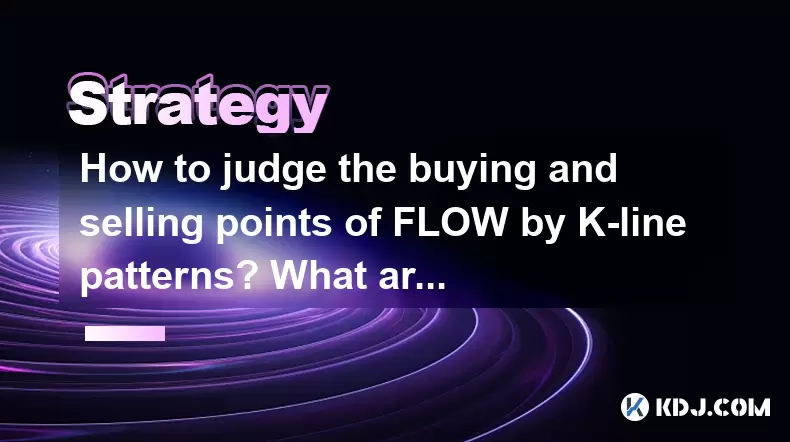
Understanding how to judge the buying and selling points of FLOW by analyzing K-line patterns is crucial for any cryptocurrency trader. K-line patterns, also known as candlestick patterns, provide visual insights into market sentiment and potential price movements. In this article, we will explore the process of identifying these patterns on the FLOW chart and discuss some of the most common patterns traders use to make informed decisions.
Understanding K-line Patterns
K-line patterns are graphical representations of price movements over a specific period. Each K-line, or candlestick, shows the opening, closing, high, and low prices for that period. The body of the candlestick represents the range between the opening and closing prices, while the wicks or shadows show the high and low prices. By analyzing these patterns, traders can predict potential market trends and make decisions on when to buy or sell FLOW.
Identifying Buying Points with K-line Patterns
When looking for buying points, traders often focus on patterns that indicate a potential reversal from a downtrend to an uptrend. Here are some common patterns to watch for:
Hammer and Inverted Hammer
- Hammer: This pattern appears at the bottom of a downtrend and signals a potential bullish reversal. It has a small body and a long lower wick, indicating that sellers pushed the price down, but buyers managed to push it back up.
- Inverted Hammer: Similar to the hammer, this pattern also appears at the bottom of a downtrend. It has a small body and a long upper wick, suggesting that buyers tried to push the price up, but sellers managed to bring it back down. However, the presence of this pattern can still indicate a potential bullish reversal.
To identify these patterns on the FLOW chart:
- Look for a downtrend in the price of FLOW.
- Identify a candlestick with a small body and a long lower wick (hammer) or a long upper wick (inverted hammer).
- Confirm the pattern with subsequent bullish candlesticks to validate the potential reversal.
Bullish Engulfing
The bullish engulfing pattern is another strong indicator of a potential buying point. It occurs when a small bearish candlestick is followed by a larger bullish candlestick that completely engulfs the body of the previous candlestick. This pattern suggests that buyers have taken control and a bullish reversal is likely.
To identify a bullish engulfing pattern on the FLOW chart:
- Look for a downtrend in the FLOW price.
- Identify a small bearish candlestick followed by a larger bullish candlestick that engulfs the body of the previous candlestick.
- Confirm the pattern with subsequent bullish candlesticks to validate the potential reversal.
Identifying Selling Points with K-line Patterns
When looking for selling points, traders focus on patterns that indicate a potential reversal from an uptrend to a downtrend. Here are some common patterns to watch for:
Shooting Star and Hanging Man
- Shooting Star: This pattern appears at the top of an uptrend and signals a potential bearish reversal. It has a small body and a long upper wick, indicating that buyers pushed the price up, but sellers managed to push it back down.
- Hanging Man: Similar to the shooting star, this pattern also appears at the top of an uptrend. It has a small body and a long lower wick, suggesting that sellers tried to push the price down, but buyers managed to bring it back up. However, the presence of this pattern can still indicate a potential bearish reversal.
To identify these patterns on the FLOW chart:
- Look for an uptrend in the price of FLOW.
- Identify a candlestick with a small body and a long upper wick (shooting star) or a long lower wick (hanging man).
- Confirm the pattern with subsequent bearish candlesticks to validate the potential reversal.
Bearish Engulfing
The bearish engulfing pattern is a strong indicator of a potential selling point. It occurs when a small bullish candlestick is followed by a larger bearish candlestick that completely engulfs the body of the previous candlestick. This pattern suggests that sellers have taken control and a bearish reversal is likely.
To identify a bearish engulfing pattern on the FLOW chart:
- Look for an uptrend in the FLOW price.
- Identify a small bullish candlestick followed by a larger bearish candlestick that engulfs the body of the previous candlestick.
- Confirm the pattern with subsequent bearish candlesticks to validate the potential reversal.
Other Common K-line Patterns
In addition to the patterns mentioned above, there are several other common K-line patterns that traders use to judge buying and selling points for FLOW:
Doji
A Doji is a candlestick with a very small body, indicating that the opening and closing prices are very close or the same. This pattern suggests indecision in the market and can signal a potential reversal. There are several types of Doji patterns, including:
- Standard Doji: The opening and closing prices are the same, resulting in a cross-shaped candlestick.
- Long-Legged Doji: The opening and closing prices are the same, but the candlestick has long upper and lower wicks, indicating significant volatility.
- Dragonfly Doji: The opening and closing prices are at the high of the candlestick, with a long lower wick, suggesting a potential bullish reversal.
- Gravestone Doji: The opening and closing prices are at the low of the candlestick, with a long upper wick, suggesting a potential bearish reversal.
To identify Doji patterns on the FLOW chart:
- Look for a candlestick with a very small body.
- Identify the type of Doji based on the position of the opening and closing prices and the length of the wicks.
- Confirm the pattern with subsequent candlesticks to validate the potential reversal.
Morning Star and Evening Star
- Morning Star: This is a three-candlestick pattern that signals a potential bullish reversal. It consists of a long bearish candlestick, followed by a small candlestick (which can be bullish or bearish) that gaps down, and then a long bullish candlestick that gaps up and closes above the midpoint of the first candlestick.
- Evening Star: This is a three-candlestick pattern that signals a potential bearish reversal. It consists of a long bullish candlestick, followed by a small candlestick (which can be bullish or bearish) that gaps up, and then a long bearish candlestick that gaps down and closes below the midpoint of the first candlestick.
To identify these patterns on the FLOW chart:
- Look for a long bearish candlestick followed by a small candlestick and then a long bullish candlestick (morning star) or a long bullish candlestick followed by a small candlestick and then a long bearish candlestick (evening star).
- Confirm the pattern with subsequent candlesticks to validate the potential reversal.
Practical Application of K-line Patterns
To effectively use K-line patterns to judge buying and selling points for FLOW, traders should follow these steps:
- Analyze the Overall Trend: Before looking for specific patterns, understand the overall trend of FLOW. Is it in an uptrend, downtrend, or ranging?
- Identify Key Levels: Identify key support and resistance levels on the FLOW chart. These levels can help confirm the validity of K-line patterns.
- Look for Patterns: Scan the chart for the K-line patterns discussed above. Pay attention to the context in which these patterns appear.
- Confirm with Volume: Use volume data to confirm the validity of the patterns. A pattern accompanied by high volume is more likely to result in a significant price move.
- Set Entry and Exit Points: Based on the identified patterns and confirmed trends, set clear entry and exit points for your trades.
- Use Stop-Loss Orders: Always use stop-loss orders to manage risk and protect your capital.
Frequently Asked Questions
Q: Can K-line patterns be used in conjunction with other technical indicators?
A: Yes, K-line patterns can be effectively combined with other technical indicators such as moving averages, RSI, and MACD to enhance trading decisions. For example, a bullish engulfing pattern confirmed by a bullish crossover in the MACD can provide a stronger signal to buy FLOW.
Q: How reliable are K-line patterns in predicting price movements of FLOW?
A: While K-line patterns can provide valuable insights into potential price movements, they are not foolproof. Their reliability can vary depending on market conditions and the timeframe used. It's important to use them in conjunction with other analysis tools and to always manage risk appropriately.
Q: Are there any specific timeframes that are more effective for using K-line patterns with FLOW?
A: The effectiveness of K-line patterns can vary across different timeframes. Shorter timeframes like 15-minute or 1-hour charts may provide more frequent trading opportunities but can be more volatile. Longer timeframes like daily or weekly charts may offer more reliable signals but fewer trading opportunities. Traders should experiment with different timeframes to find what works best for their trading style.
Q: How can I practice identifying K-line patterns without risking real money?
A: Many trading platforms offer demo accounts where you can practice identifying K-line patterns and executing trades with virtual money. This allows you to gain experience and refine your skills without financial risk. Additionally, using historical data to backtest your strategies can help you understand how different patterns have performed in the past.
Disclaimer:info@kdj.com
The information provided is not trading advice. kdj.com does not assume any responsibility for any investments made based on the information provided in this article. Cryptocurrencies are highly volatile and it is highly recommended that you invest with caution after thorough research!
If you believe that the content used on this website infringes your copyright, please contact us immediately (info@kdj.com) and we will delete it promptly.
- Do Kwon, Terra (LUNA), Developments: What's the Latest?
- 2025-06-30 04:30:12
- MAGACOIN vs. Dogecoin: Riding the Crypto Growth Wave in 2025
- 2025-06-30 04:30:12
- Dogecoin, Ruvi AI, and Gains: A New Era of Crypto Opportunities?
- 2025-06-30 04:50:12
- Crypto Market Weekly Winners: PENGU and SEI Shine Amidst Volatility
- 2025-06-30 04:57:13
- Altcoin Season, Bitcoin Dominance, and the 2025 Outlook: Will XRP and Cardano Lead the Charge?
- 2025-06-30 04:36:44
- Token Unlocks and Altcoins: Navigating the Massive Release Landscape
- 2025-06-30 04:40:13
Related knowledge
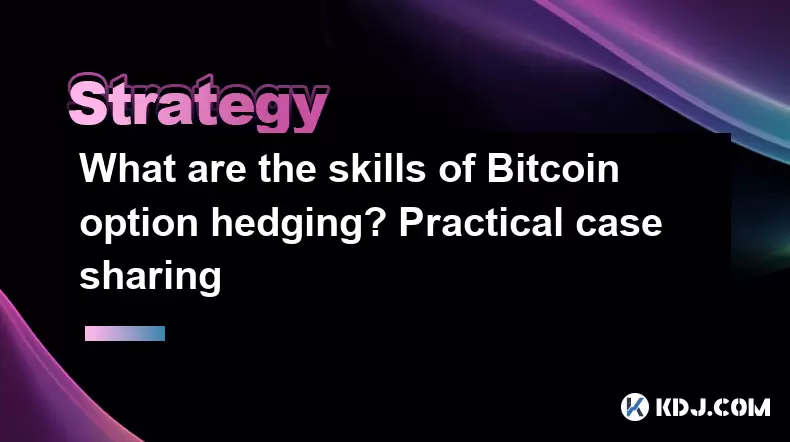
What are the skills of Bitcoin option hedging? Practical case sharing
Jun 24,2025 at 04:01pm
Understanding Bitcoin Option HedgingBitcoin option hedging is a risk management strategy used by traders and investors to protect their positions in the volatile cryptocurrency market. By using options, individuals can limit potential losses while retaining the opportunity for profit. In essence, it allows one to insulate against adverse price movements...
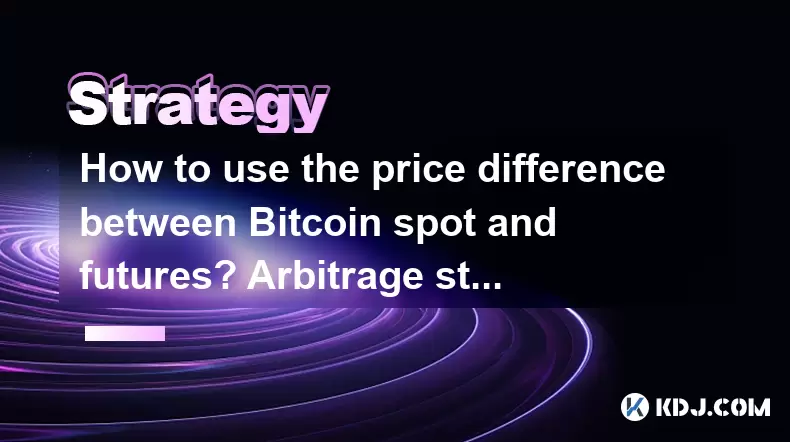
How to use the price difference between Bitcoin spot and futures? Arbitrage strategy
Jun 20,2025 at 02:56pm
Understanding Bitcoin Spot and Futures MarketsTo effectively leverage arbitrage opportunities between Bitcoin spot and futures markets, it's essential to understand the fundamental differences between these two types of markets. The spot market refers to the direct buying and selling of Bitcoin for immediate delivery at the current market price. In cont...
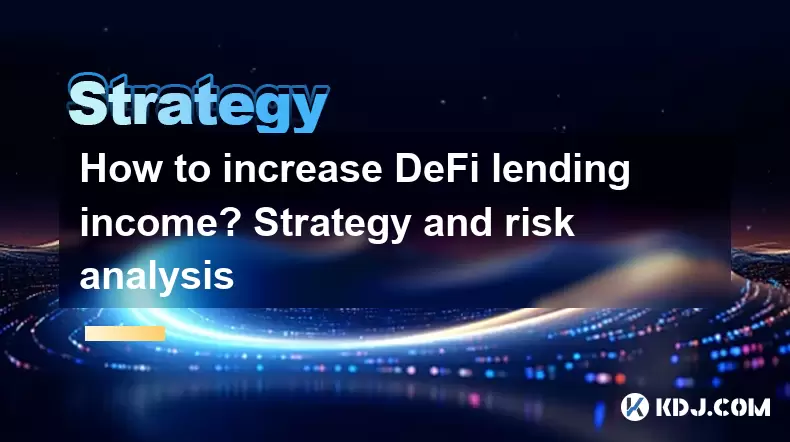
How to increase DeFi lending income? Strategy and risk analysis
Jun 24,2025 at 02:08pm
Understanding DeFi Lending and Its Income PotentialDeFi (Decentralized Finance) lending has emerged as a popular way to earn passive income in the cryptocurrency space. Unlike traditional banking systems, DeFi lending platforms allow users to lend their crypto assets directly to borrowers without intermediaries. The lenders earn interest based on the su...
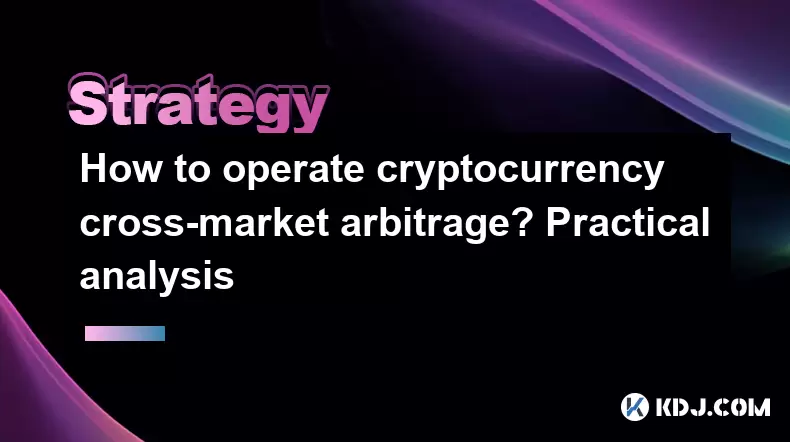
How to operate cryptocurrency cross-market arbitrage? Practical analysis
Jun 23,2025 at 04:01am
Understanding Cryptocurrency Cross-Market ArbitrageCryptocurrency cross-market arbitrage involves taking advantage of price differences for the same digital asset across different exchanges. The core idea is to buy low on one exchange and sell high on another, capturing the profit from the discrepancy. This strategy relies heavily on real-time market da...

How to make profits from high-frequency cryptocurrency trading? Sharing core skills
Jun 19,2025 at 05:07pm
Understanding High-Frequency Cryptocurrency TradingHigh-frequency trading (HFT) in the cryptocurrency market involves executing a large number of trades at extremely fast speeds, often within milliseconds. This method relies on small price discrepancies across exchanges or within a single exchange’s order book. Traders use complex algorithms and ultra-l...

What are the methods of cryptocurrency quantitative trading? Detailed analysis
Jun 22,2025 at 11:07pm
Understanding the Core of Cryptocurrency Quantitative TradingCryptocurrency quantitative trading refers to the use of mathematical models and algorithms to execute trades in the digital asset market. Unlike traditional discretionary trading, which relies heavily on human judgment, quantitative trading leverages data-driven strategies to identify profita...

What are the skills of Bitcoin option hedging? Practical case sharing
Jun 24,2025 at 04:01pm
Understanding Bitcoin Option HedgingBitcoin option hedging is a risk management strategy used by traders and investors to protect their positions in the volatile cryptocurrency market. By using options, individuals can limit potential losses while retaining the opportunity for profit. In essence, it allows one to insulate against adverse price movements...

How to use the price difference between Bitcoin spot and futures? Arbitrage strategy
Jun 20,2025 at 02:56pm
Understanding Bitcoin Spot and Futures MarketsTo effectively leverage arbitrage opportunities between Bitcoin spot and futures markets, it's essential to understand the fundamental differences between these two types of markets. The spot market refers to the direct buying and selling of Bitcoin for immediate delivery at the current market price. In cont...

How to increase DeFi lending income? Strategy and risk analysis
Jun 24,2025 at 02:08pm
Understanding DeFi Lending and Its Income PotentialDeFi (Decentralized Finance) lending has emerged as a popular way to earn passive income in the cryptocurrency space. Unlike traditional banking systems, DeFi lending platforms allow users to lend their crypto assets directly to borrowers without intermediaries. The lenders earn interest based on the su...

How to operate cryptocurrency cross-market arbitrage? Practical analysis
Jun 23,2025 at 04:01am
Understanding Cryptocurrency Cross-Market ArbitrageCryptocurrency cross-market arbitrage involves taking advantage of price differences for the same digital asset across different exchanges. The core idea is to buy low on one exchange and sell high on another, capturing the profit from the discrepancy. This strategy relies heavily on real-time market da...

How to make profits from high-frequency cryptocurrency trading? Sharing core skills
Jun 19,2025 at 05:07pm
Understanding High-Frequency Cryptocurrency TradingHigh-frequency trading (HFT) in the cryptocurrency market involves executing a large number of trades at extremely fast speeds, often within milliseconds. This method relies on small price discrepancies across exchanges or within a single exchange’s order book. Traders use complex algorithms and ultra-l...

What are the methods of cryptocurrency quantitative trading? Detailed analysis
Jun 22,2025 at 11:07pm
Understanding the Core of Cryptocurrency Quantitative TradingCryptocurrency quantitative trading refers to the use of mathematical models and algorithms to execute trades in the digital asset market. Unlike traditional discretionary trading, which relies heavily on human judgment, quantitative trading leverages data-driven strategies to identify profita...
See all articles

























































































